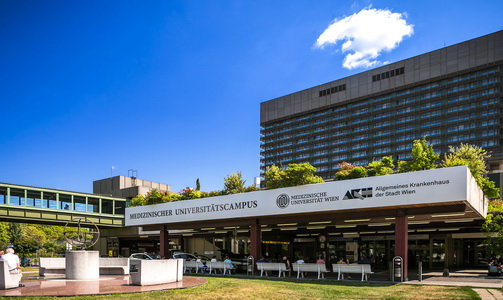
Medizinische Universität Wien
The Medical University Vienna (MUW) is one of the largest biomedical research institutions in Europe, with a clinical tradition of 650 years. It employs over 4000 people, including 1600 physicians and 2600 researchers, and is linked to the General Hospital of Vienna, which is Europe’s largest hospital, with 550.000 outpatient and 105.000 inpatients treated every year. The MUW relies on a “triple track” strategy combining research, education and patient care, which enables advancements from bench-to-bedside and back, a unique inter-linking of foundational research and clinical applications. Within the MUW, interdisciplinary and translational research is addressed by research clusters that connect 27 University Clinics, 3 Clinical Institutes and 8 Medical-Theoretical Institutes. Among the 5 research clusters within the MUW, the Cardiovascular and the Medical Imaging clusters will be relevant for this project proposal. These clusters address questions of basic science, diagnostics/imaging, and organ failure/transplantation/replacement. The MUW offers in addition to studies in human medicine and dentstry, also Doctoral Study programs (PhD and Dr.-sci.-med.) in Biomedical Engineering, Physics and Imaging, and Organ Transplantation, which are available for the advanced education of the early-stage researchers involved this project.
The activities for NeuHeart will be coordinated by the Center of Medical Physics and Biomedical Engineering (Prof. Francesco Moscato), and it will include collaboration with the Dept. For Cardiac Surgery (Prof. Andreas Zuckermann), the Center for Biomedical Research (Bruno Podesser and Attila Kiss). The numerical modelling of internal organs and therapeutic devices as well as the experimental investigation with the isolated heart are core tasks of the Biomedical Engineering group, with particular experience in the hemodynamic modelling of pathologically modified organs and organ replacement/assistance, as well as the pioneering clinical evaluation of physiological control for ventricular assist devices (Heinrich Schima). This experience has its foundations on a deep understanding of the interaction between heart, lung and circulation, with devices, such as cardiac assist devices, cardiac valves and vascular prostheses.
Hemodynamic modelling is done in conjunction with the clinical application of the therapeutic ,devices at the Dept. for Cardiac Surgery and the Rehabilitation Clinic. The direct contact with ,patients and clinicians allows the engineers immediate insight into pathophysiological developments and the individual therapy course. In addition, “real” patient data collection and its analysis are extremely important for the modelling purpose, for model reliability and validity.
The isolated-heart experiments will be done in collaboration with the Center for Biomedical ,Research, which is the animal facility of the Medical University of Vienna, which will provide ,also outstanding experience in the isolated-heart experiments as well as whole animal experimentation.
